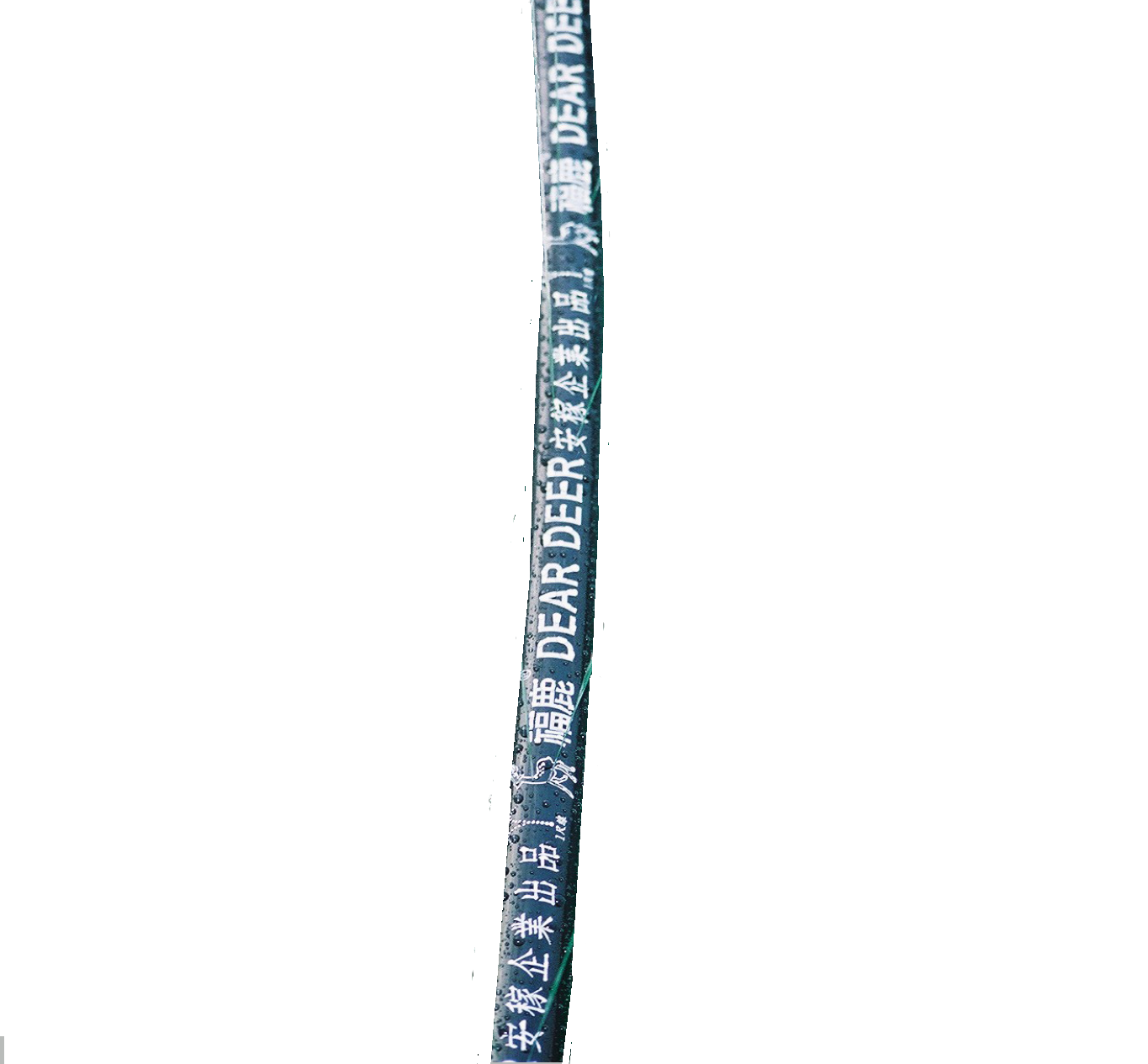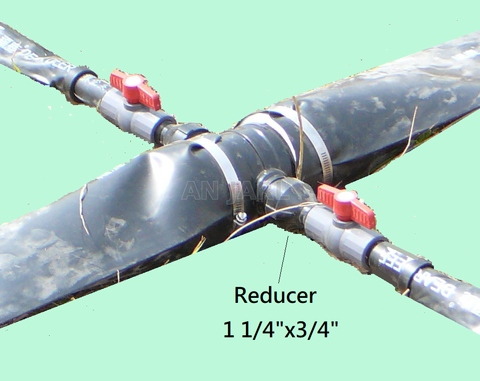Small single irrigation sprinkler hose is AJ-101 series with smaller hose diameter. Except 3/4" the hose less than this diameter has not the type with 3 pores each section. The smaller the hose the less of the pore amount or the smaller the spray pore.
The type without 3 pores each section may have 2 pores each section which may has not center pores to water the center area along the sprinkler hose. Or the sprinkler may has 1 pore each section to spray.
AJ-101 DEAR DEER single sprinkler hose is a flat hose with thin thickness hose wall to be punched with regular perforations. It is simplest and cheapest type of sprinkler hose. DEAR DEER sprinkler hose irrigation is the easiest way of farmland irrigation.
DEAR DEER irrigation sprinkler hose also named as rain tape, rain pipe, rain hose, micro irrigation spray tube, perforated tube etc. It is a flat hose with many pores on the hose to spray water mistily. Irrigation sprinkler hose irrigation system easy to install, easy to maintain, low cost, easy plug clearing, quick irrigation, and low water pressure, low energy consuming for farm irrigation.
It is suitable for any crop or plant in dry land. There are different types of sprinkler hose, different watering pore pattern, for different crops and different farmlands. Can be used to open farmland, sandy land, greenhouses, net house. Especially it is suitable for crop nursery or the plants require more water in short time.
The use life of sprinkler hose is about 2-5 years, depending on how to use and how to maintain.
Most sprinkler hose laid on the ground, but some types can be hang on air.
Sprinkler hose as another name spray tube, it can spray on the air and fall down like little rain at open field so sprinkler also named as rain tape or rain pipe. In addition sprinkler hose may cover under mulch film to spray and drip under the mulch film.
While laid on the ground, the sprinkler hose is sprayed upward into the air, and then fall down at 2 sides. There are many patterns of pores of these types.
The use under mulch film, the spray pores farther away from the center line, the spray angle is low. Plants grow outward from the holes on the mulch film. Sprinkler hose is under the mulch film along the line of crop cultivation, near crops.
While Irrigate, the water discharged from the sprinkler hose pores, flow directly to crop roots in the soil. If necessary, liquid fertilizer can be added in the water, along go together to the root of the crops. In fact, this is another way to drip, but the drip rate is faster than the drip irrigation.
Sprinkler hose irrigation system is generally not necessary to install a filter, unless the type of very tiny pore or much impurities in the water.
As long as the water pumped to the pond firstly, so that the dirt can be precipitated in the pond.
In the absence of the pump case, it can still do short distance irrigation.
Because of the required working pressure is very low, as long as there is a tank height of more than 1 m, it can make the water down from the tank to the hose and flow out from the pores. This is a simple drip irrigation especially for short distance crop line. To use sprinkler hose irrigation system to drip is easier and more acceptable to farmer. Especially its material and maintain cost are much than regular drip system. This is the cheapest drip irrigation method.
No matter this irrigation hose named sprinkler hose or rain tape, rain pipe, rain hose, spray tube, perforated tube, it all means a flat hose with perforated pores on it and spray water as raining.



What is the best pipe for irrigation system?
How does a lawn irrigation system work?
How much is irrigation pipe?
How do you connect PVC to sprinklers?
From Wikipedia, the free encyclopedia
https://en.wikipedia.org/wiki/Micro-irrigation
Micro-irrigation, also called localised irrigation, low volume irrigation, low-flow irrigation, or trickle irrigation is an irrigation method with lower pressure and flow than a traditional sprinkler system. Low volume irrigation is used in agriculture for row crops, orchards, and vineyards. It is also used in horticulture in wholesale nurseries, in landscaping for civic, commercial, and private landscapes and gardens, and in the science and practice of restoration ecology and environmental remediation.
Contents
Description
There are several types of micro-irrigation systems. Many of the components are the same for all of these types of systems. Most systems typically include filters, pipes, valves, and tubing. The main difference is in the type of emission device that is used to deliver the water to the plants. Drip irrigation utilizes drip emitters that deliver water at very low rates. The typical range is 0.2 to 4.0 gallons per hour. In some systems, the emitters are installed manually on the outside of the tubing and placed where needed. Other systems might use integral dripper line or drip tape with the emitters already installed at a predetermined spacing. Micro-sprinklers, which can include fixed stream sprays and rotating spinners typically deliver water at a higher rate, such as 10 to 25 gallons per hour and will cover a larger area than drip emitters. These are more typically used in tree orchards where the plants are larger. The goal is to distribute water slowly in small volumes and target it to plants' root zones with less runoff or overspray than landscape and garden conventional spray and rotary sprinklers. The low volume allows the water to penetrate and be absorbed into slow-percolation soils, such as clay, minimizing water runoff.
System components
There are a wide variety of system components included in a micro-irrigation systems. Most systems include a filter. These may include pre-filters, sand separators, media filters, screen filters, and disc filters. The level of filtration required depends on the size of the emission device and the quality of the water source. A pressure regulator or regulating valve may be required to reduce the system pressure to the desired level. Automatic or manually operated valves will be required to switch from one irrigated section to another. An irrigation controller will be used with automatic systems and may also be needed for back flushing the filter or sand separator. Since water conservation is a frequent reason for choosing micro-irrigation systems, soil moisture sensors, rain shutoff sensors, and sometimes even weather stations may be installed.
Emission devices
Microtubing
Microtubing is one of the oldest types of drip irrigation devices and was used in greenhouses in the 1970s. It consists of a very small diameter tubing. Flow is regulated purely by the length and diameter of the tubing. Weights or stakes are sometimes attached to the end of the tubing to keep it in place.
Fixed flow drip emitters
Low-flow irrigation systems in gardens using drip apply water through two methods:
pre installed small holes in small diameter tubes placed on or below the surface or
self cleaning emitters, in different precipitation rates, pre installed or contractor installed for different rate emitters on same supply line (i.e. trees-higher, perennials-lower). The Flexible supply pipe can be buried either underground or pinned on the surface and buried under
Low volume irrigation systems often use the two delivery components of drip systems to apply water through small holes in small diameter tubes placed on or below the surface of the field. This is done instead of agricultural surface irrigation and furrow irrigation for vegetables, fruits and berries, and other high-value crops.
Adjustable drip emitters
Trickle emitters, also called 'spider sprays,' come in fixed or adjustable radius shapes and diameters, and are installed directly on the flexible supply pipe or on tubing connected to it, and mounted on small stakes. Trickle emitter-'Spider sprays' work well for plants with more fibrous root systems, tree and large shrub basins, and in pots and container gardens - allowing automated watering of plants on decks and patios. Mist emitters can also be used in pot, both on the ground and hanging, with humidity-fog watering for epiphytes and ferns replicating habitats.
In the Horticulture industry, wholesale growers and plant nurseries often use the trickle emitters for 5-US-gallon (19 L) and larger container stock, to automate watering. Attached to longer supply tubing on short stakes, they are easily movable to new containers when stock is moved or sold. Mist emitters are used for propagation, epiphytes, and other plants needing higher humidity.
Micro-sprinklers
Low volume micro-sprinklers may be attached to hard plastic risers or attached to standard sprinkler heads, but are more typically mounted on stakes and attached to small diameter micro-tubing connected to polyethylene tubing with a barbed connector. Some micro-sprinklers have a fixed spray or stream pattern, while others rotate. These are installed above ground and are often used for fruit and nut orchards and vineyards. These systems are expensive, even for large-scale agricultural use, and are predominantly used for high-value crops.
Macro-Drip irrigation
High-volume, low-pressure irrigation systems for container gardening are known as Macro-Drip. A pressure regulator lowers the water pressure to under 30 pounds per square inch while a relatively large diameter hose or pipe delivers the water directly to a sprinkler head.[1] This allows a larger volume of water to reach the flowerpot in a short amount of time, which will then be absorbed into the roots of the plant.
Sprinkler
Sprinkler Irrigation[2] is the process of providing water to your land. This process works with the number of pipes. It is then partitioned with the help of Sprinklers that spreads the water all over in an equal balance. One can gain optimum solutions by installing sprinkler Irrigation. Sprinkler Irrigation helps in decreasing the labor cost saves upto 20% - 40% water supply. It can be applied to any soil that helps to increase crop production. There are a wide variety of sprinklers available in the market. One can choose carefully from the best of sprinkler systems.
Ecological restoration and phytoremediation projects
Low-flow irrigation systems are used on some native plant habitat restoration and environmental remediation projects. The lower operating pressure can be the only choice for remote locations with wells or small storage tank water sources. It is used in temporary installations during initial establishment periods, and being on the soil surface easily removable with minimal damage to the recovering plant community. An example is its use in riparian zone restoration, and environmental remediation projects using Phytoremediation and Bioremediation techniques.
Water conservation and regulations
As municipal and agricultural water supplies become more limited; through increased population demands, droughts, and climate change; city, water district, and state-province level regulations and codes are beginning to encourage, offer rebates with use, or mandate significantly reduced water allowances, at higher costs, that are bringing many water conservation products and techniques both to the forefront and more competitively matched to traditional irrigation system costs.
Use of micro-irrigation systems on green building candidate projects can help them to accumulate points for LEED - (Leadership in Energy and Environmental Design) certification rating and awards.
See also
Deficit irrigation
Drip irrigation
Irrigation in viticulture
Groundwater recharge
Water conservation
References
Garden Time TV (2019-04-26), Daisy Rain Garden System, retrieved 2019-04-29
"How do Sprinkler Irrigation Systems Work? | Automat Industries". Automat Irrigation Blog. 2019-08-06. Retrieved 2019-09-18.
This article incorporates public domain material from the Congressional Research Service document "Report for Congress: Agriculture: A Glossary of Terms, Programs, and Laws, 2005 Edition" by Jasper Womach.
External links
DWP-Be Water wise blog: "The Garden Spot"
Categories: Irrigation Low-flow irrigation systems Water conservation Sustainable agriculture Sustainable gardening


